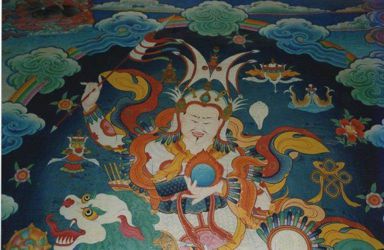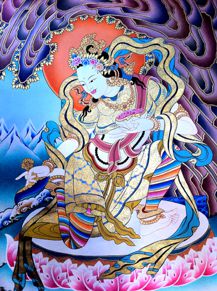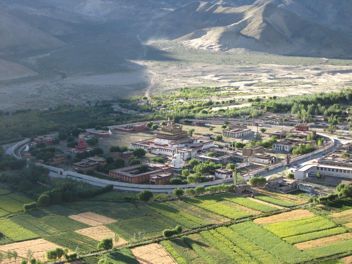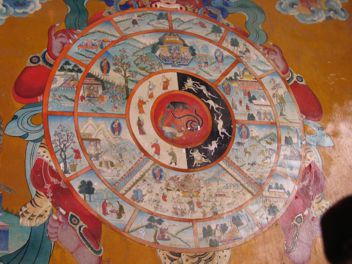


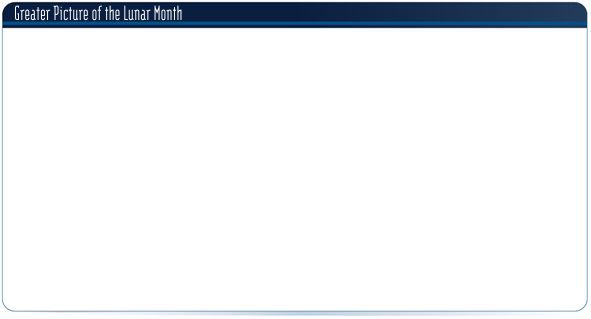

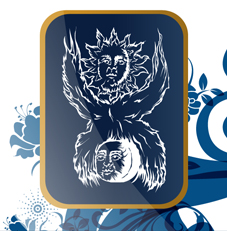


THE GREATER PICTURE OF THE LUNAR MONTH AND ITS FESTIVALS(The following is excerpted from my book The Full Moons: Topical Letters on Esoteric Astrology, the chapter of the same name. You can see more about the book at www.malvinartley.com/news_west.htm ) The extra periods of meditative focus in the lunar cycle: a larger picture. Spiritual powers and the eighth day of the moon The bodhisattva powers and the tenth day of the moon The fifteenth day and the emptying of samsara—the purpose of the full moon What is service? The 25th day and the dark half of the moon.
The extra periods of meditative focus in the lunar cycle: a larger picture: What are these extra periods of meditative focus throughout the remainder of the lunar month? Traditions will vary, but perhaps the best example and one that has continued uninterrupted for centuries can be found in the great Tibetan Buddhist traditions. Some insight can be gleaned from Padmasambhava’s[1] parting instructions to Tibet’s greatest yogini, protectress and female saint, Yeshe Tsogyel: …Thus in the future on the tenth day of the moon[2] Pema Jungne will come riding on the Lord of the day In peaceful, enriching, dominating and destructive forms, During the four successive quarters of the day, To give corresponding siddhis to my spiritual sons. In the same way, I will appear on the tenth day of the waning moon, To accomplish, in particular, all dominating and destructive acts. On the fifteenth of the month, riding the rays of the moon, I will stir the depths of samsara with my compassionate prayer, Emptying the lower realms without exception, Working perfectly with power for the sake of beings. On the eighth day of the moon, after nightfall and before dawn, At sunset and sunrise, riding my all-wise steed, Traveling through the power places of the world, I will bestow various siddhis: In the land of the vicious demonesses I will turn the wheel of the teaching; For all beings of the twenty-one barbarian islands And the thirty most savage lands, To pacify, enrich, dominate or destroy, Emanating as fire, wind or water, As sky, as rainbow, or earthquake or thunder, I will dispatch a million apparitional forms to guide them to happiness; There will be no interruption to my work for beings...[3]
On the 10th and the 25th and on the 8th and 15th days of the moon, Celebrate the ganachakra feast and make offerings— A single celebration closes the door to rebirth in the lower realms, And I swear that it will carry you to the level of irreversible release. Take that as a solemn promise[5] It is a uniform practice in Tibetan Buddhism (Vajrayana Buddhism, especially) to perform pujas on the 10th and 25th days of the lunar month. However, the ganachakra feasts referred to in Tsogyel’s account are a far cry from the pujas we see today in monastic settings. But what is significant to astrologers and meditators alike, is the angular relationship between the sun and moon from the start of the lunar month, or the new moon, and what those times actually mean in terms of practice. We will look at the meaning of those times in due course, but the angular relationship is as follows (in the order of the quote): 10th day: The Moon is trine (120°) the lunation point (the degree of the new moon), the lower trine. 25th day: The Moon is at the applying sextile (60°) to the Sun, just prior to the beginning of the dark phase of the moon. This marks the preparation for the coming lunar month, and a wrapping up of affairs of the passing month. (These first two are the traditional offering days in Mahayana Buddhism.) 8th day: The Moon is square (90°) the Sun, at the lower square, and just past the square of the lunation. 15th day: The day of the full moon, or in the full moon period. The Moon is opposite (180°) the Sun. Spiritual powers and the eighth day of the moon: [This is the Day of Tara Pujas in Mahayana practices.] The angular relations listed above hold true if the lunar month is twenty-nine days in length, the figures being off a little bit if the lunar month has thirty days. When we look in more detail at the activities of Pema Jungne on those days the significance of his activities in reference to the angular relationship of the sun and moon will be clear to astrologers: 1) On the eighth day of the moon, after nightfall and before dawn, At sunset and sunrise, riding my all-wise steed, Traveling through the power places of the world, I will bestow various siddhis: On the eighth day the Moon is square the Sun. In astrology, the square is a dynamic aspect conferring constructive activity: the ‘stress that leads to success.’ We are told all the time in the great spiritual teachings of the world that if we make effort we will guarantee ourselves success, or spiritual attainment.[6] Even though the square is a stressful aspect, it gives one the needed push to attain one’s goals. It is of interest to note that of all the days of the lunar month listed in Pema Jungne’s last instruction, on only one day are the Sun and Moon in a trine aspect, which is an aspect of comfort and ease, or of grace. All the other days are devoted to activities of some sort, and the angular relationships are of the ‘hard aspects’—semisquare, square, sesquisquare and opposition. Siddhis (supernormal, or psychic powers) are also called attainments in Buddhism, and the type of siddhis referred to here are the higher, or uncommon siddhis, which are evolved once one has stepped onto the bodhisattva ground—the powers of a true initiate, although anyone may develop them with due care and motivation. There are several of these powers and an indication of what is bestowed in these periods for those who are ready to receive them is given in one of the Alice Bailey books: The question of psychic powers is not so easy to explain. I do not refer to the lower psychic powers which may or may not develop as time goes on and the need for them arises. I refer to the following capacities, inherent in the soul, which must be developed…if you are to do your share in meeting world need...Let us briefly enumerate them: 1. Intuitional response to ideas. 2. Sensitiveness to the impression which some member of the Hierarchy may seek to make upon the mind of the disciple. It is for this reason that I am training you to utilise the Full Moon contact. 3. Quick response to real need. You had not regarded this as one of the psychic powers, had you? I refer not here to a solar plexus reaction but to heart knowledge. Ponder on this distinction. 4. Right observation of reality upon the soul plane. This leads to right mental perception, to freedom from illusion and glamour and to the illumination of the brain. 5. Correct manipulation of force, involving, therefore, an understanding of the types and qualities of force and their right creative weaving into service upon the outer plane. 6. A true comprehension of the time element, with its cyclic ebb and flow and the right seasons for action—a most difficult psychic power to master, but one which can be mastered through the use of patient waiting and the elimination of hurry. All these powers, the disciple must eventually develop, but the process is necessarily slow.[7] …This first day of Jungne’s activity sets in motion the days to come and confers the powers needed to ensure the success of the needed work for the month, whatever that may be, that work having been indicated at one or other of the lunations. Also of interest in the quote from the book Sky Dancer at the beginning of this chapter regarding the activities of Jungne during the lunar month is the fact that on the eighth day he is active during the night hours, when most of the world is asleep, and at sunrise and sunset. This is when the phenomenal world would be more quiescent and the consciousness of sentient beings more open to impression. The bodhisattva powers and the tenth day of the moon: 2) …Thus in the future on the tenth day of the moon Pema Jungne will come riding on the Lord of the day In peaceful, enriching, dominating and destructive forms, During the four successive quarters of the day, To give corresponding siddhis to my spiritual sons. [This is the Daka’s Day in Vajrayana practices.] On this day, Pema Jungne is active during daylight hours—“riding on the Lord of the day”—the sun. The same is true on the 25th day of the lunar month. On this 10th day “peaceful, enriching, dominating and destructive forms” are manifested. The peaceful and enriching forms we can understand from the nature of the trine between the sun and the moon. The destructive and dominating forms are not usually associated with the trine, except that they are carried out as a beneficent influence and an act of grace in order to ease suffering. Though it is not stated whether the four types of activities are each carried out during a specific quarter of the day, this would be a fair inference, as these times of day are typically followed in the monasteries of Tibet, upon which Pema Jungne was the primary influence and wherein intensive work along subjective lines is undertaken. Dawn to mid-morning gives peace and a tranquil mind. Morning is the primary time for meditative practices as the brain is fresh from the night’s rest and we may emerge from the hours of sleep with impressions of the subtle realms visited during the night’s repose. Enriching activities are undertaken from mid-morning to noon, the time for study after meditative practices—for the enrichment of the mind. Noon to mid-afternoon is the dominant part of the day. The sun is directly overhead and the full force of solar activity is felt, a clear reference to the activity of the solar angel over the lunar nature. From mid-afternoon to dusk the day begins to wind down and our activities are recounted prior to the yogas of the night. The “spiritual sons” mentioned are the bodhisattvas—initiates of the third degree or higher—and there are many millions of these in the world. The destructive activities involve the elimination of mental obstructions for the most part. 3) On the fifteenth of the month, riding the rays of the moon, I will stir the depths of samsara with my compassionate prayer, Emptying the lower realms without exception, Working perfectly with power for the sake of beings. The fifteenth day and the emptying of samsara—the purpose of the full moon: [This is the day of Amitabha in Mahayana Buddhism.] Here we come to the day of the full moon, the main festival day addressed in this book. At the day of the full moon the Sun and Moon are 180° apart, an aspect that is said to bring awareness. The greater initiations—expansions of consciousness—are said to be given at the time of the full moon.[8] Here we have a most interesting and inspiring passage, and a very apt description of the work of a world savior, as are all the great initiates of the world. Pema Jungne, or Padmasambhava, was the key instigator of the establishment of Buddhism in Tibet. The first major Buddhist monastery in Tibet was established under Padmasambhava’s guidance—Samye[9], shown below[10]—which is still functioning to this day, and the Nyingma tradition in Tibetan Buddhism. What exactly do we find in this passage, taking a closer look?
“I will stir the depths of samsara with my compassionate prayer”: Samsara refers to six realms of existence—the hells, the realms of the hungry ghosts (pretas), the animal kingdom, the human kingdom, the realms of the demi-gods and the god realms. Clearly, samsara involves any type of being possessing one of the five aggregates and thus lunar and solar beings alike. We are apt to think of the solar angel, or soul, as perfect, but it too has its own lessons and karma to work out. It is thus bound in samsara, or to the wheel of life and death just as the personality is, but its cycles of life encompass eons of time. The six realms of samsara are inclusive of the five planes, from the physical plane to nirvana.[11] To “stir the depths of samsara” means that every aspect of samsara receives stimulation, or Light, during the full moon and that no life is forgotten, no darkness is unilluminated during the period of any full moon. That should give inspiration and hope to those who seek to progress on the way. “Emptying the lower realms without exception”: This refers to the lower realms of samsara, which are the hell realms, the preta realms and the animal kingdom. What does it mean to empty those realms? For an animal to escape its limitations and progress to the higher realms (kingdoms), it needs more Light, or realization—conscious mind. It needs to evolve mentally to a stage wherein it is no longer animal in its intelligence, and this entails periods of stimulation and purification usually over eons of time. Thus, this passage does not mean that the lower realms will be totally emptied at each full moon. Rather, it means that beings in each of the lower realms will receive the needed stimulation at every full moon that will eventually lead to their liberation. However, it might be useful if we touched briefly on this subject of the lower realms. Westerners, upon being exposed to Buddhist teachings on the lower realms, are struck by the constancy of their mention in Buddhist literature, although Christians will already be well acquainted with the concept of hells—even though this subject is typically met with confusion, skepticism or outright rejection by most in Western audiences. It is of interest to note that Theosophically-based writings almost never mention ‘lower realms’ in terms of karmic retribution, except for the very wicked.[12] We are told instead that if one is basically moral and does their best to live within the bounds of society and decency, then there is no need to fear the lower realms. Nevertheless, as a tool for discipline, belief in these realms—and especially the possibility of rebirth there—would be a very effective motivation to practise for some students. People can and do change when they are confronted with suffering due to their actions. Periods of deprivation and suffering are the great purifiers of human nature and motivators to better actions in most cases, and in relatively short periods of time from the standpoint of a human life. Such are the roles of Mars, Saturn and Pluto in esoteric astrology.
Rebirth by a human in the animal realms is said to be the karmic outcome of a life given over to stupidity and prejudice. For a human to take rebirth there infers a lack of thought or use of the mind solely for meaningless pursuits. This is not the view of Theosophy but is widely held in Buddhism and Hinduism…Pretas, or hungry ghosts, are a foreign concept to most Westerners. A preta is a being who lives in a realm where their desires are never met, having to endure extremes of hunger, thirst, sensual appetites, and so on. A life there is said to last hundreds of years. Pretas are typically depicted as having large bellies (indicating the insatiability of the appetites),[15] thin necks and tiny mouths (symbolizing inability to satisfy the desires). To be reborn in the preta realm is a result of overindulgence while living in base desires of all sorts, and one would be unable to fulfill those desires any longer for want of a body after death. This description is probably allegorical, referring to what is described in Theosophical literature as inhabitants of the lowest levels of the astral plane, or desire realm.[16] In summary, these are the causes of rebirth in the lower realms: · Preta: the result of overemphasis upon baser desires of any sort, usually relating to covetousness, gluttony, sexual appetites, and addictions. · Animal: the result of willful non-thinking, i.e., wishing to remain comfortable in one’s ignorance.
The three lower realms are not physical locales, but are instead states of existence. The animal realm is determined by instinctive mind. The preta realms refer to the astral plane. The hell realms are more physical and sensation-based, and are largely seen as being subterranean realms. There are cold hells and hot hells, and hells for every element. “Working perfectly with power for the sake of beings”: Here we have the essence of the purpose and opportunity provided at each full moon. Each full moon is meant as a sort of relay station between the greater forces that guide our world and humanity, and the intermediaries are the great meditators—those in human incarnation and those who have passed beyond (the spiritual hierarchy of the planet, or Community of Souls). At the time of each full moon there is a great effort made to further the work of our world’s evolution. Pema Jungne, as an exemplar of a spiritual friend, savior and member of the spiritual hierarchy, was able to manifest the power and compassion (love) needed to “stir the depths of samsara” and thus bring about the needed means for this work. In other words, he had a great capacity for service. Greater capacity for service is just what is furthered and fostered during each lunar month through its various meditative stations, as listed by the days in the quote at the beginning of this chapter. The siddhis (powers) granted to the bodhisattvas of our planet at the key times of the lunar month being outlined here are intended solely for the purpose of service, not for the satisfaction of the bodhisattva, who cares for none of that anyway. Those siddhis are exactly what enables a bodhisattva to be of greater service…For virtually anyone reading these words, for myself as well, this sort of service is an ideal, not yet fully realized, but it comes to all of us at some point… The 25th day and the dark half of the moon: [This is the Dakini’s Day in Vajrayana practices.] Let us finish with the last day, and then we will address what is probably one of the more important considerations in this entire work—the stages of meditation and their affects. Continuing with the final significant day of the lunar month: 4) In the same way, I will appear on the tenth day of the waning moon, To accomplish, in particular, all dominating and destructive acts. The Moon on the 25th day of the lunar month (10th day of the waning moon) is semisquare the Sun. The semisquare confers that ‘stress that leads to success,’ as do the squares, oppositions and sesquisquares (135°). However, the semisquare has a unique energy for on the 25th day of the month there is a ‘winding down’ and the energies released at the full moon are finding their needed outlets, finding application in preparation for the next lunar month. There is also a sealing away of certain forces that seek expression during the ‘dark half of the moon’—a misnomer, because this really only covers a period of about one week, not fourteen days (half the lunar cycle). This ‘dark half’ begins at the final crescent of the moon and ends at the waxing crescent. This period, however, is said to be when the less desirable forces of the world are most active—the forces of black magic and gross materialism.[17] The dark half of the moon is when people who meditate regularly are apt to notice that darker moods intrude upon their thoughts. People are more open to negative influences during the dark half of the moon. Meditation at the time of the new moon—or the central part of the ‘dark half’—requires an added vigilance not give into negative emotional and mental states. [This is why Shakyamuni Day always falls on the new moon.] For instance the dark half of the moon is a period wherein we can be most vulnerable to depression, which affects meditative work.[18] This last day of the lunar month mentioned by Pema Jungne is thus a day wherein certain practices are carried out that will serve to ‘seal the door where evil dwells,’ and also to confer those siddhis to the bodhisattva when needed that will aid in this work. It is said among Buddhist teachers that the first tsog day (offering day) of the month, the 10th lunar day, is for constructive activities, whereas the second tsog day is for wrathful (destructive, or purgative) activities.[19] This is a day wherein wrathful forms (dharmapalas, or protector deities/forces) are employed to subdue the more stubborn aspects of mind and emotions in meditative work. The aim of all this is to ensure that spiritual evolution proceeds apace, that obstacles to the Great Work, or Dharma, are removed: For all beings of the twenty-one barbarian islands And the thirty most savage lands, To pacify, enrich, dominate or destroy, Emanating as fire, wind or water, As sky, as rainbow, or earthquake or thunder, I will dispatch a million apparitional forms to guide them to happiness; There will be no interruption to my work for beings...[20] Pema Jungne is saying that even though he passed into paranirvana (attained full buddhahood) at the end of his life, his work for this world will never cease until the realms of samsara are emptied. He has also indicated here his chosen path—the path of Earth service.[21] There is really no greater statement of love for all beings than that, and it expresses the Pisces phase exactly—that of the world savior. However, what is outlined in this quote is not simply a statement by and about Padmasambhava, nor is it strictly related only to Buddhism or Tibet. What I am suggesting here is that the process outlined at each lunar month is a universal one, although Buddhism, and Tibetan Buddhism in particular, are the current best-known custodians of the rites. The source of the Alice Bailey material and much of The Secret Doctrine was said to be a Tibetan Buddhist monk at the time, and rituals performed on these days would have been observed at the monastery where he was reputedly the abbot. The lands and islands mentioned in the quote are regions from and surrounding ancient Tibet at the time of Padmasambhava (ca. 8th century), but they could equally apply to anywhere on earth. “Emanating as fire, wind or water, As sky, as rainbow, or earthquake or thunder…”: In the West we are schooled to regard such things as earthquakes as being the result of forces of nature, outside of human or super-human influence. Yet, we are told that there is a department of the spiritual hierarchy of our world—the department of the Manu—that works with and produces just such events in order to further the aims of planetary evolution and to affect the consciousness of people.[22] In the Bailey books we are told this department of the hierarchy guides the development of the human race through the development of the human form, through the congealing or separation of races or groups, through natural calamities that cause people to migrate and to rethink their lives and through wars, which serve the same purposes as natural disasters in many cases, but which also bring the great racial types into contact with each other. So, strange as it may seem, all these events are primary means of guiding the development and beneficent evolution of the human family. All of this work is done through super-physical means, which then results in the physical manifestations we see as weather events, volcanic activity, earthquakes and the like. Eclipses of either the sun or the moon presage or indicate such events, as signals of activity in the department of the Manu. So we can see that Padmasambhava most likely either worked closely with the Manu or was a member of that department. He was of pivotal importance to the Tibetan people and has subjectively been one of the main guides in their spiritual development for 1,200 years. Now the Tibetan race is dispersed throughout the world as a result of the Chinese occupation of Tibet. One might well wonder what acts of service were rendered by their dispersion—not to in any way mitigate or condone the suffering they have undergone. Certainly Tibetan Buddhist practices of meditation have spread throughout the world and in the West particularly, which would not likely have happened nearly so quickly had the Chinese not invaded the Land of the Snows. Astrologers know that great world events are most often indicated and presaged by eclipses, both lunar and solar. These are the events that produce movements of people and changes in public consciousness, that provide karmic clearing or restitution for masses or groups of people. If the department of the Manu guides such changes and eclipses forecast them, what does this say in connection with the Sun and the Moon, the Manu and humanity, the evolution of consciousness and the evolution of the human race? Further, what does it mean with regard to the Sun and Moon veiling the planets that govern one’s evolution on the spiritual path? We can say without equivocation that the lunar cycle—that is, the angular relationship between the Sun and Moon throughout the lunar month—is probably the prime indicator of the activity of the Manu and of the driving forward of the greater purposes of this planet. Buddhism as a spiritual tradition—not in its orthodox religious form—is probably the primary outward manifestation of that department of spirituality in the world today. Meditation shows us the light on the path, as does the sign Taurus, and it is no accident that Shakyamuni, or Gautama Buddha, was born in the sign of Taurus. “I will dispatch a million apparitional forms to guide them to happiness. There will be no interruption to my work for beings”: In this we have the essence of the pledge of all fully enlightened teachers—that their work for the benefit of all beings still bound to the wheel of birth and death will continue “until the lower realms are emptied.” The lower realms here refer to all the personal and subhuman realms of rebirth. The work of these great beings continues so long as they are connected with our world. And if not all beings achieve their evolutionary gains by the end of this world period? They will receive opportunity to do so in another world period, perhaps even on another world, such as those who did not achieve their goals on the Moon Chain:[23] us, in other words. The work of the great teachers and saviors of the world proceeds unabated and all people have opportunity for spiritual advancement and full enlightenment, the goal for the humanity of our present world. When Padmasambhava says he “will dispatch a million apparitional forms to guide them to happiness,” what does that actually mean? Why would apparitional forms be used to guide people to enlightenment? Why not simply grant people immediate full enlightenment by some magical means? Well, that is just not the way things work on this planet, this “globe of painful endeavor.”[24] We seem to have to do things the hard way, through our own self-effort and by dint of perseverance. We have karma to work off, and our own stubborn mental misconceptions to deal with. We must learn to use our powers for the greater good. This idea of apparitional forms is very tied in with the idea of emanation. An emanated form is one that is sent by an enlightened being as a way of instruction and as a signpost, an example. When we encounter such a great being, we see only the lowest part of the emanation of that being, the rupakaya, illusory body, or nirmanakaya. We do not see the truth of the being, the essence. If we did, it is unlikely we would recognize it for what it is anyway. In the West we are taught to be skeptical of such things and to see them as tricks or fakery, and we automatically give ourselves over to doubt. This is in many cases an advisable approach, since we are taught even by the Buddha himself to test the veracity of every experience and thought. When a being manifests a power for our benefit, for example, (which is rare) it is as a means of instilling faith in the processes that got the being to the state of enlightenment. How is the evolution of the average person accelerated by the world teachers? How is the higher essence of a person drawn out? It is said that the quality of the soul is usually only seen in times of crisis[25] until the late stages of the path, and for most of us that means we have to periodically go through what on the surface are seen as hard times or calamities, which in reality is often an effort to get us to look at ourselves and care for others and to test our mettle in service. Such times can be seen as a service provided for us, through our karma and by the higher Self. Is it so difficult for us to see an earthquake, for instance, or any of a number of similar world events as a magical emanation or apparitional form? When calamity strikes in our lives or in the lives of others, what is our response? Do we think only of relieving the suffering of such an individual or even a nation, or do we think to ourselves, “Poor souls! There is nothing really that I can do for them, however,” and just continue eating our morning toast and then get on with our day without another thought of it? The thing is, we are presented with apparitional images all the time if we were to think deeply on the matter. Every form that we see, in essence, is an apparition—a false view—and even the basics of Buddhism teach us that. Yet, we somehow manage to get to full enlightenment through the morass of those forms and in spite of our concepts of them, for even a concept is a form and thus unreal in its essence. The means are provided for all of us to tread the path and to walk it well and in confidence. All we have to do is read the signposts and follow the way. Just how do we do that, though? The chief means is through meditation…(the book continues through the stages of meditation) …The ‘turning of the wheel’ of the zodiac underpins every stage of meditative attainment and colors the life of the disciple until enlightenment is achieved. Not even the most realized of beings escapes its influence. I would say at this point that the rising sign a person is born under will indicate the type of meditative practice that would most benefit, describe or concern them for that particular life, and at every level of meditation. If the ascendant indicates the way forward in any life, then certain types of meditative practice are indicated or inferred. This is particularly apparent if one reads through the descriptions of the signs in Esoteric Astrology in relation to Table I in this section. Much progress towards right understanding of astrology will come later when certain new meditations on the twelve signs of the zodiac are made available. When the world again settles down to calmer living and conditions are adjusted to a more stable rhythm, these new meditations can form a potent source of usefulness in "brightening the web of life" and in producing more effective spiritual living among humanity.[26] When one—through abandonment of self-cherishing, dedication to service, self-discipline and mental training—attains some higher realization and has a touch of the true mind of enlightenment (a true intuition, in other words), then something else takes over in the life of that person and it is realized without doubt that they do not function alone, that they are bound up within a subjective, inner group of like minds. This leads us to a consideration of “The Law of Group Progress,” which is also one of the effects of all meditative practice, properly undertaken: This Law of Group Progress embodies one of the energies which have gradually been released over the past two centuries. [This has real significance if the progress of society and culture is considered in the framework of the past 200 years.] A fuller tide was swept into activity at the time of the May, 1936, full moon and now the growth of the group idea, both in its good and bad aspects, can be imminently expected. [This was a major precipitating factor in the last World War.] As has several times been pointed out to students, this law is connected with a certain realised impulse in the minds of humanity, and this is, in its turn, the effect of various types of energy, which are playing upon the earth. The name "Law of Group Progress" is the phrase given by human beings to a particular type of energy which is producing the coherence of units in a group, thus forming them into one living organism. The recognitions eventuating are those of group affinity, group objective, and group goal. It is, in the last analysis, the emergence into the subjective consciousness of the same type of energy which produces that aspect of cohesive action which demonstrates as tribal, national or racial unity. In this case, however, the determining factor is not of a physical connotation nor have these groups a physical plane basis. They are based on a group idealism which can only be consciously registered when the units in the group are beginning to function upon the mental plane and are developing the capacity to "think things through" —that is, to register in the brain that which the soul has imparted to the mind. We have here a definition of the meditation process as it should be followed by those who, through alignment, have made some measure of soul contact. These groups are functioning entirely through a subjective relation, which produces a subjective integration and activity. When we come to study the astrological implications in connection with these laws, we shall discover that the energies of the zodiacal signs have a specific effect upon the energy of a Being, Whose purpose works out into manifestation through these laws, which are regarded by us as great and inevitable natural laws and also spiritual laws. This effect produces a blending of energies which is both balancing and, at the same time, impelling.[27] Here we have the end purpose of all meditative work as it relates to the world in general and to one’s inner group in particular, especially in relation to the full moon periods. Each full moon presents us with certain astrological energies—those energies represented for us in the duality of the opposing signs in which the Sun and the Moon are placed. The full moon also presents us with an open doorway through which transcendent subjective energies are more readily available to us than at other times of the year. The quality of those energies and the type of force they represent are outlined for us in the types of meditative focus and the accompanying attainments associated with their successful application through the astrological signs. Thus all aspects and attributes of divinity are presented and available to us throughout the year. Through the annual cycle everyone has opportunity, everyone is served and likewise serves, and we thus all progress—together, not as individuals—although we may feel ourselves to be isolated in our outer circumstances. Once we have touched the realms of the arya beings and have abided there, even for an instant, then we are forever under the influence of the Law of Group Progress. We are never again alone. This is, indeed, a compelling and thus an impelling thing to consider. “And I swear that it will carry you to the level of irreversible release. Take that as a solemn promise.” [1] Pictured is Padmasambhava, also known as Pema Jungne (Tibetan: pad ma byung nas, or “He who has arisen from the lotus”) or Guru Rinpoche (Tibetan: gu ru rin po che, meaning “Precious Master”). Picture courtesy of Ada Maria Bianchi. [2] Bolding added for emphasis. [3] Keith Dowman, Sky Dancer: The Secret Life and Songs of the Lady Yeshe Tsogyal, Snow Lion Pubs., Ithaca, NY, USA, 1966, p.130. [4] Yeshe Tsogyal, (Tibetan: ye shes mtshog gyal, or “She who is the great, clarifying ocean of wisdom”) pictured, thangka from http://pbc-tn.org/sites/default/files/page-images/YesheT1.JPG. [5] Ibid, p. 184. [6] Of course, this guaranteed success may and probably would not come in a single lifetime, although great progress in one life can be made, especially if one’s vows to one’s path and inner and outer commitments thereto are fully engaged. The timing of attainment is individual and dependent on many factors, one of the most important being one’s karma, which cannot ultimately be offset. Patience with oneself and others must be cultivated in this regard, with an acceptance that no honest effort goes unrewarded, although the timing of the reward may take some time to realize. [7] Discipleship in the New Age I, p. 38. [8] HP Blavatsky, Collected Writings Vol. XIII, p. 11, commentary on the 6th verse of the Pistis Sophia, The Theosophical Publishing House, Wheaton, Ill., USA. [9] In Tibetan: bsam yas, meaning, literally, “infinite,” or “inconceivable”—“The Unchanging and Spontaneously Perfected Temple.” The temple complex was modeled after the Indian monastery Odantapuri, built under the patronage of King Trisong Detsen (790–844) (Tibetan: khri srong lde bstan: “The god-king who reveals the teachings”) and consecrated by Padmasambhava in 814 CE. It is the seat of the Nyingma tradition—the “old tradition.” [10] Photo by the author, 2009, taken from atop Mt. Hepori near sunset. See also: http://www.sacred-destinations.com/tibet/samye-monastery. [11] See Appendices 1 and 3. [12] Avici: the non-returning hell, reserved for only the most willfully wicked of people. In Theosophy this realm is usually the end result of the life or lives of black magicians, who become separated from their higher principles through the force of their own will. However, one is not condemned to any lower realm. Rather, one ends up in any one of them by their own design, there to work off their karma until they purify the lower aspects of themselves and the karma that led them there is exhausted. [13] The realms according to Buddhism are pictured, above, in the wheel of life and death. See: http://en.wikipedia.org/wiki/Bhavacakra . Photograph is by the author, taken from a fresco at Samye monastery in Tibet, 2009. [14] This is further discussed in the last chapter of this book. [15] Pretas, from Phabongka Rinpoche, Liberation in the Palm of Your Hand, pp. 339 –345, Wisdom Publications, Boston, new revised edition, 2006. [16] Charles W. Leadbeater, The Astral Plane, Theosophical Publishing House, pp. 16 & 17. [17] HP Blavatsky Collected Writings Vol. XII, p. 204, from the section “Thoughts on the Elementals.” [18] A Treatise on White Magic, the section “Astral Energy and Fear, subsection, II. Depression or its polar opposite, hilarity.” [19] This information was given in a lecture by Ven. Khensur Kangurwa Rinpoche at a tsog (ritual offering) ceremony in 2010 at Tekchen Shedrub Choeling: Tibetan Buddhist Institute, Adelaide, South Australia. [20] Keith Dowman, Sky Dancer: The Secret Life and Songs of the Lady Yeshe Tsogyal, Snow Lion Pubs., Ithaca, NY, USA, 1966, p. 130. [21] I say this based upon the following, from Externalisation of the Hierarchy, pp. 531, 532: “This Path, as you know, keeps the Masters attached to service in the three worlds for a period much longer than the average. It involves tremendous sacrifice. Just as the disciple has to live a dual life, with one part of his reflective nature and awareness centred in the life of the Hierarchy and the other part of his mental responsiveness equally centred on life in the three worlds, and this simultaneously, so the Master, when He chooses this Path, forms a constituent part of the Council Chamber of the Lord of the World and at the same time works consciously in the three worlds, via the Hierarchy (of which He remains also a part), and with the human and subhuman kingdoms in nature.” [22] The department of the Manu. See: A Treatise on Cosmic Fire, pp. 65, 258 especially p. 380; The Externalisation of the Hierarchy, p. 170. [23] A Treatise on Cosmic Fire, p. 364. [24] See Appendix 9. [25] “We grow by the presentation of moments of crisis.” (Discipleship in the New Age I, instructions to S.C.P., Jan. 1938.). “Learn to feel joy—a joy which is based on the knowledge that humanity has always triumphed and passed onward and forward in spite of apparent failures and the destruction of past civilisations; a joy, which is founded upon the unshakable belief that all men are souls, and that "points of crisis" are factors which are of proven usefulness in calling in the power of that soul, both in the individual man, in a race, or in humanity as a whole; a joy which is related to the bliss which characterises the soul on its own level whereon the form aspects of manifestation do not dominate.” (Ibid., instructions to D.I.J., Feb. 1938.) “The life of the disciple moves forward through moments of crisis. These crises produce two results: 1. The intensification of aspiration, if the disciple is still upon the Probationary Path, or the intensification of illumination if the disciple is nearing the Path of Accepted Discipleship, or is upon the Path itself. 2. The achievement of a more stabilised attitude of detachment, based upon conscious personality renunciation, upon a right orientation of the personality to the soul… (Ibid., instructions to J.S.P., Sep. 1937.) [26] Esoteric Astrology, p. 277. [27] Esoteric Psychology II, the section “The Seven Laws of Soul or Group Life, IV d. Astrology and the New Groups.” |

